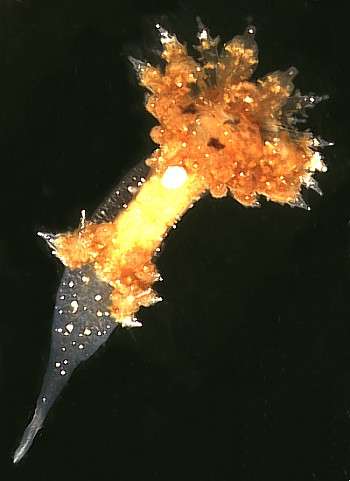Janolus mirabilis from Heron Island
June 30, 1999
From: Julie Marshall


Here are two images of Janolus mirabilis which Baba & Abe (1970) described from a single specimen found in Toyama Bay, Japan, in 1958. As far as I am aware it has not been recorded since except at Heron Island. This specimen measured 4 mm and was found under a dead coral slab at the reef crest at low tide in December 1997. This species is readily identified by the exceptionally large cerata which are arranged in two clusters ,with the larger cluster encircling the rhinophores. There are insignificant papillae in the large space between the clusters. Janolus mirabilis moves with a rapid, jerking movement flicking its cerata backwards and forwards as it moves.
I found it difficult to photograph Janolus mirabilis because it moved so quickly across the petri dish - in fact is is probably the fastest moving small nudibranch I've encountered.
Reference: Baba, K. & Abe, T. 1970. Two new species of Janolidae from Toyama Bay, Japan (Gastropoda : Nudibranchia). The Veliger 13 (1): 63-66.
Julie Marshall
j.marshall@latrobe.edu.au
Marshall, J., 1999 (Jun 30) Janolus mirabilis from Heron Island. [Message in] Sea Slug Forum. Australian Museum, Sydney. Available from http://www.seaslugforum.net/find/988
Dear Julie,
Thanks for the pictures of Janolus mirabilis. I must agree its difficult to photograph. Your mention of its jerky movement reminded me I had found it in Tanzania, East Africa many years ago and was fascinated by the way it moved its cerata. I have included a couple of field drawings I made of a small specimen. The interesting thing was that the ceratal movement was very organised. As the animal crawled forward the cerata would be lying horizontally then all the cerata in the posterior cluster and the back cerata in the anterior cluster would stand up vertically in unison, then all bend down and so on. This rhythmic motion would give the impression that the slug was jerking as it moved along even though it was crawling quite smoothly.
This unpublished record from Tanzania, with yours from Heron Island, suggests that it has a wide Indo-West Pacific distribution.
The data for my record is:
Pangavini Island, off Kunduchi Beach, Dar es Salaam, Tanzania, October 1976, 6mm long alive.
Bill Rudman.
Rudman, W.B., 1999 (Jun 30). Comment on Janolus mirabilis from Heron Island by Julie Marshall. [Message in] Sea Slug Forum. Australian Museum, Sydney. Available from http://www.seaslugforum.net/find/988Related messages
-
Janolus mirabilis found sthn Queensland
From: Gary Cobb, November 17, 2009 -
More records of Janolus mirabilis
From: Terry Gosliner, July 1, 1999
